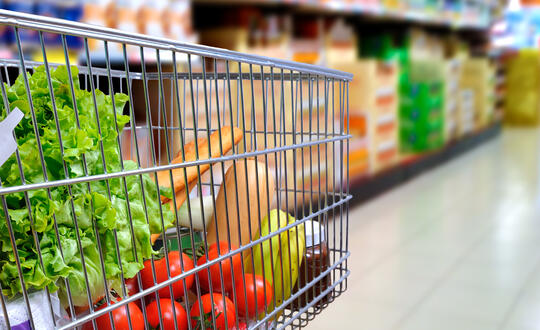
As the UK economy faces up to the challenge of rapid decarbonisation, important changes must be made by both retailers and consumers in order to achieve the targets that have been set. The UK has one of the most vibrant and dynamic retail industries in the world; it accounts for 5% of our economy, contributes £17billion in business taxes and has a higher productivity growth than almost any other industry[1]. However, the retail industry contributes roughly 215 million tonnes of Co2 emissions per year[2].
The British Retail Consortium (BRC) recognises this issue and have launched a Climate Action Roadmap, which sets to de-carbonise the retail industry by setting realistic and challenging targets. We spoke to Andrew Opie, Director of Food and Sustainability at the BRC, about the roadmap and what businesses can do to accelerate their progress to net zero emissions.
As part of the Climate Action Roadmap, the BRC have set out five decarbonisation pathways:
- Placing greenhouse gas data at the core of business decisions.
- Operating efficient sites powered by renewable energy.
- Moving to low carbon logistics.
- Sustainable sourcing of materials.
- Helping employees and customers live low carbon lifestyles.
Focus on what is in your control
Opie told us that retailers should first start by focusing on what is in their control to make an immediate difference. Pathway 4 of the Climate Action Roadmap involves the "sustainable sourcing of materials", which aims to help retailers develop common systems to encourage suppliers to make the changes to lower carbon products.
Certain industries, such as fast fashion, are recognised as problematic due to the high levels of carbon emissions they produce, with some estimates suggesting that the fashion industry produces around 8% of global carbon emissions and nearly 20% of wastewater[3]. This places the retail industry amongst the highest contributors to emissions in the UK. Opie told us that the driving interest in carbon most commonly comes from board level, who are being pushed to act progressively by consumers and investors. The BRC believe that joining the roadmap is beneficial for any retailer; not only can the industry influence emission reductions of both suppliers and customers, but it can also mobilise considerable action to address the climate change emergency – both within the industry and beyond.
Living sustainably with unsustainable prices
The BRC found that 88% of consumers want retailers to help them live more sustainably. However, in light of the current cost of living crisis, consumers face new challenges as they are unable to meet the costs associated with doing so. Opie explained that, in this sense, price has become a big consideration in whether one chooses to live sustainably or not. The BRC recognises this issue and appreciates the challenges that both consumers and retailers are facing. To engage the market to help retailers meet demand, the BRC introduced pathway 5 to the roadmap which covers "helping employees and customers live low carbon lifestyles".
When a business considers the lifestyle of a product, they also need to take into account the product's land, water and soy use, Opie told us. Businesses then need to communicate this to the consumer to allow them to make an informed choice on the products they use. Balancing these issues can be difficult and often conflicting, which causes consumers to make trade-offs, such as making vegan choices due to animal welfare over environmental factors.
Don’t be daunted
Opie told retailers that they should not be daunted by the net zero journey, nor science-based targets, as there is great support available. There is a broad range of companies who have signed up to the roadmap, ranging from the UK’s largest supermarkets to smaller online companies. Joining the roadmap will allow retailers to begin breaking down the ways in which they can make small internal changes to make a difference.
The BRC have set their own target to reach net zero by 2040, with stores and warehouses powered by net zero power systems by 2030 and zero carbon operations and deliveries by 2035.
"Moving to low carbon logistics" forms pathway 3 under the roadmap, which surrounds how retailers can cut their energy use. This will assist with the BRC's plans for the retail industry to achieve net zero emissions from operations, including fleet vehicles and heating fuels and gas. However, HGVs currently run off diesel, so in order to move away from this, the manufacturers who build these vehicles will need government support to start producing more sustainable vehicles, which run off energy sources such as hydrogen supply or overhead wires. Therefore, government support is vital to playing a huge part in whether these targets are achieved.
The BRC wants to take customers on the journey to net zero with them, which is a crucial part to reaching the roadmap’s ambitious 2040 target. Whilst the BRC aims to make living sustainably as easy as possible by providing customers with resources to make informed choices and making packaging and sourcing more sustainable, the drive for change ultimately lies with consumers.
To further support retailers, the BRC created pathway 1 which aims to "place greenhouse gas data at the core of business decisions". To do this, the BRC partners with organisations, such as WRAP's Textiles 2030, who aims to accelerate the whole fashion and textiles industry's move towards circularity and system change in the UK. Textiles 2030 will give retailers raw data to enable them to make easier choices when it comes to sourcing materials. It is important retailers have access to science-based evidence, since they have signed up to science-based targets.
The BRC runs regular webinars to share tips and support businesses. Opie recommends retailers start with this type of support before implementing wider strategies and changes.
Start on your supply chain
Building efficiency within a business cuts carbon and cuts cost. Opie explained that retailers should begin with their supply chain to make an immediate difference, such as considering the choice of materials they use and waste. Once retailers progress with their own net zero journey, they can then begin to invest and consider where priorities are best placed.
The dominant emission sources across all retailer properties are heating, lighting, and refrigeration. Retailers could look to see if they can source renewable energy and install efficient technologies to lessen the emission sources they produce. This forms pathway 2 of the roadmap "operating efficient sites powered by renewable energy".
The journey to net zero promises significant new commercial opportunities for retailers. The rapid decarbonisation of the industry presents new opportunities to reimagine the ways consumers engage with the emerging circular, low-carbon economy, and can enable retailers to reduce costs and deliver new and exciting products and services to consumers.
This article is part of Womble Bond Dickinson’s Growing Global series. For more insights, click here to visit our Growing Global hub.
__________
[2] Climate Action Roadmap – figures say it was "based on 2017 data for UK consumption emissions from Defra"
[3] Can fashion ever be sustainable? - Christine Ro, BBC, 11 March 2020.
This article is for general information only and reflects the position at the date of publication. It does not constitute legal advice.






